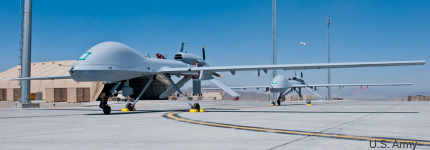Army steps up search for anti-drone technology
As UAVs proliferate, the military tries to prepare to defend against those of other forces.

As the Pentagon moves toward a future of fewer troops and more unmanned vehicles, other countries are doing the same, particularly in the use of drones. The military is trying to account for that by not only expanding its use of unmanned aerial vehicles, but looking for technologies to defend against them.
The Army has issued a sources sought notice for information that can help in developing an affordable Counter Unmanned Aerial System (CUAS). It wants to assess current capabilities and possible alternatives, as well as get an idea about what a CUAS might cost.
“U.S. forces will be increasingly threatened by reconnaissance and armed unmanned aerial vehicles (UAVs) in the near and far future,” the solicitation says. Those threats exist at all levels, micro-sized to large UAVs. “All levels of detection, decision and defeat should be considered when developing and proposing a capability.” The Army wants ideas to cover the spectrum of military operations, from the brigade level and above out to the tactical edge.
The Army notes that technologies service the tactical edge could be analogous to those used in the continental United States, where both military and other officials have discussed the potential threat from UAVs and the need for anti-UAV technology.
Officials have discussed anti-UAV measures for several years, but so far, defenses against drones mostly consist of signal jamming or blocking, and the radar detection and conventional counterattack used against any other aircraft. But the military has tested some other methods.
In September 2013, the Air Force used its T3 JSTARS test jet in a counter-UAV exercise. JSTARS, the Joint Surveillance Target Attack Radar System, is an airborne system designed to find and track ground and maritime targets, as well as slow-moving fixed-wing aircraft and rotating antennas.
In the exercise, at Naval Base Ventura County, Oxnard, Calif., JSTARS’ recently upgraded radar capabilities were used to identify and track what the Air Force defines as low, slow, small (LSS) airborne targets — that is, UAVs-- over water. That involved addition software that gave JSTARS the ability to track UAVs in addition to terrestrial and maritime targets, the Air Force said.
The Naval Postgraduate School, meanwhile, has tried fighting fire with fire, testing ‘swarming’ strategies against UAVs. In its research, NPS used swarms of kite-sized UAVs in organized, defensive measures, the challenge being to have the UAVs work together.
“Swarming is the notion of having multiple agents that work in a coordinated manner to achieve some sort of objective,” said Dr. Timothy Chung, an NPS assistant professor and director of research and education for Robotics and Unmanned Systems Education and Research (CRUSER). “It is relevant in our work here at NPS because with the presence of unmanned systems, we need to start thinking about scenarios where we or an adversary might start using large groups of these unmanned systems in a combined way.”
The Army now is looking to expand on anti-UAV research, looking for CUAS technologies that could be readily deployed in the field.




